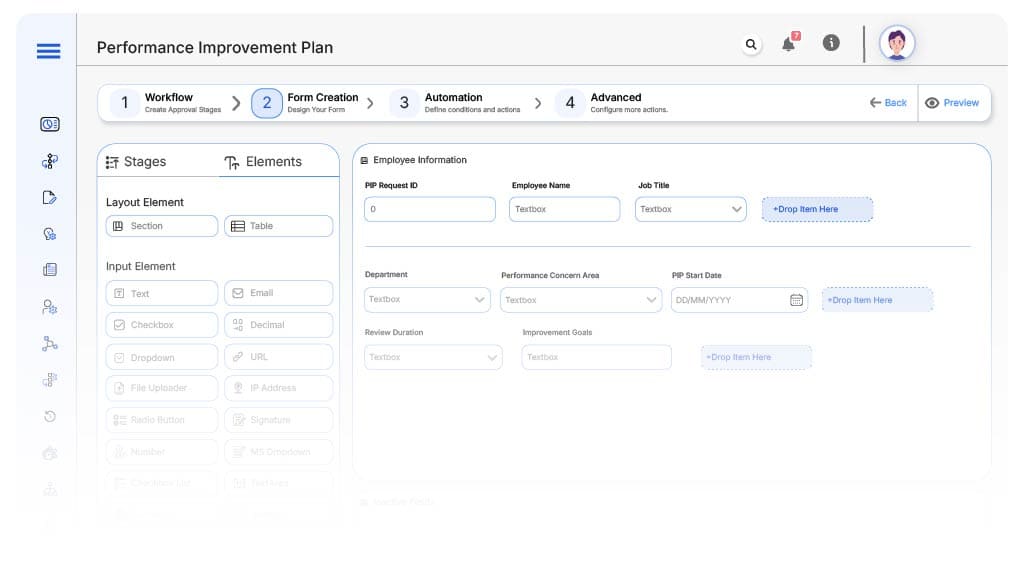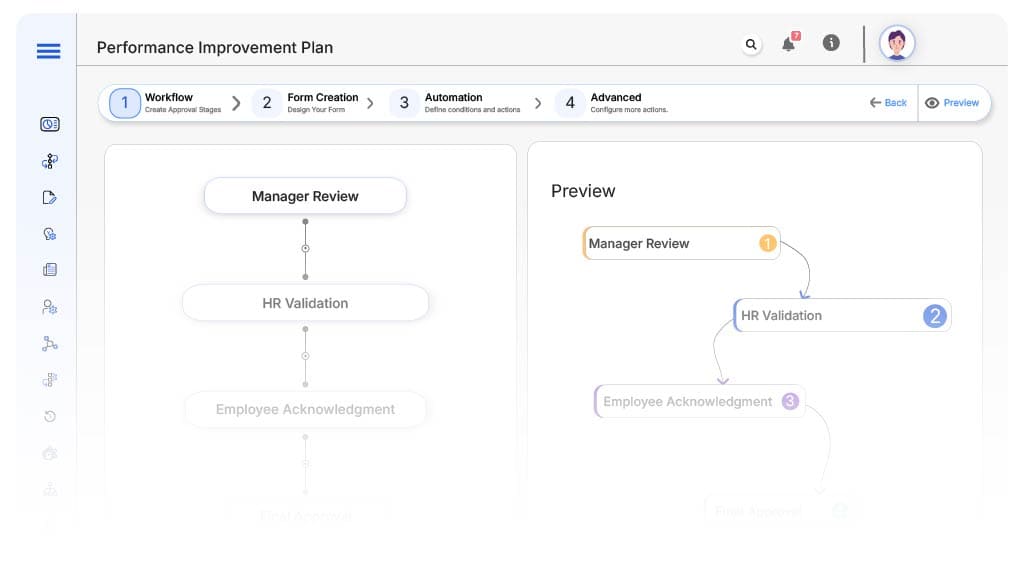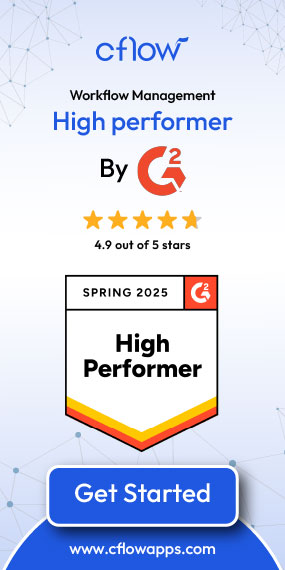- Cflow
- Performance Improvement Plan Automation
Performance Improvement Plan Automation

Clow Team

Managing employee performance challenges requires structure, clarity, and accountability. The Performance Improvement Plan (PIP) is one of HR’s most sensitive workflows, intended to help underperforming employees meet expectations through structured support and tracking. However, when handled manually, the PIP process is often inconsistent, poorly documented, and emotionally charged, leading to legal risks and disengaged employees.
Automating the PIP process ensures that HR, managers, and employees have a consistent path to follow. From goal setting to review cycles and final evaluation, Cflow standardizes each step, eliminates documentation gaps, and protects both employer and employee through compliance-ready workflows. This guide details how PIP automation works within Cflow.
What Is a Performance Improvement Plan (PIP)?
A Performance Improvement Plan (PIP) is a formal HR intervention used to address ongoing underperformance. It outlines specific areas for improvement, measurable goals, a timeline, and resources available to support the employee’s success.
Think of a PIP as a structured rehabilitation plan in the workplace. It creates a clear agreement between employer and employee, documenting expectations, milestones, and potential consequences if targets aren’t met.
According to SHRM, companies that automate performance tracking reduce employee litigation risk by over 40% due to better documentation and procedural transparency.
Why Performance Improvement Plan Automation Matters
Clarity & Structure
Manager Accountability
Employee Engagement
HR Oversight
Documentation Readiness
Key Benefits of Automating PIP with Cflow
- Centralized PIP Tracking Dashboard: Cflow consolidates all active PIPs into a real-time dashboard. HR can monitor progress, deadlines, feedback exchanges, and outcomes for every employee under a PIP without relying on disconnected emails or spreadsheets. The dashboard gives HR immediate insight into stalled plans and overdue reviews, enabling timely intervention.
- Template-Based PIP Plans: HR can create reusable PIP templates categorized by role, performance issue (e.g., punctuality, quality, collaboration), or department. Conditional logic personalizes each plan based on employee role, tenure, or prior performance history.
This ensures consistency in approach while still adapting to individual performance challenges. - Automated Reminders & Meeting Logs: Cflow triggers calendar reminders for follow-up meetings, performance checkpoints, and progress assessments. Managers log meeting notes directly within the workflow, ensuring nothing falls through the cracks. These logs become part of the employee’s performance history, useful for future evaluations or HR audits.
- Role-Based Access & Confidentiality: Only assigned managers, HR, and the employee can view or act on the PIP, ensuring confidentiality. Sensitive notes, feedback, and evaluation outcomes are fully secured with role-based access control. Granular permission settings help maintain privacy and prevent unauthorized access at every stage.
- Compliance-Ready Documentation: All activities, from plan creation to review meetings and final decisions, are timestamped and archived. HR can instantly retrieve records to support legal inquiries, employee appeals, or exit processes. The system ensures a defensible paper trail, minimizing organizational risk during disputes.
- Mobile-Friendly Interface: Managers and employees can access their assigned tasks, review goals, and submit updates from any device. This ensures ongoing engagement regardless of work location. Cflow’s responsive design makes it easy to stay on track even during travel or remote assignments.
Get the best value for money with Cflow
User Roles & Permissions
Employee Under PIP
- Responsibilities: Acknowledge plan, complete progress tasks, attend reviews.
- Cflow Permission Level: Submit / View Only.
- Mapping: “Employees Under PIP” group.
Direct Manager
- Responsibilities: Initiate plan, conduct meetings, update progress, finalize evaluation.
- Cflow Permission Level: Task Owner / Approve.
- Mapping: “Line Managers” group.
HR Representative
- Responsibilities: Monitor plan, ensure fairness, validate documentation.
- Cflow Permission Level: Admin.
- Mapping: “HR Team” group.
Department Head (Optional)
- Responsibilities: Review plan for high-sensitivity roles or escalations.
- Cflow Permission Level: Approve / Reject.
- Mapping: “Leadership Review” group.
Legal or Compliance Auditor
- Responsibilities: Access archived records for audits or litigation defense.
- Cflow Permission Level: View Only.
- Mapping: “Compliance” group.
Discover why teams choose Cflow
Form Design & Field Definitions

Field Label: PIP Request ID
- Type: Autonumber
- Auto-Populate: Generated upon creation.
Field Label: Employee Name
- Type: Text (Read-only)
- Auto-Populate: Pulled from HRIS.
Field Label: Job Title
- Type: Text
- Auto-Populate: From HRIS.
Field Label: Department
- Type: Dropdown
- Auto-Populate: From HRIS.
Field Label: Performance Concern Area
- Type: Dropdown (e.g., Attendance, Task Completion, Communication, Teamwork)
- Logic/Rules: Required.
Field Label: PIP Start Date
- Type: Date Picker
- Logic/Rules: Must be within next 7 days.
Field Label: Review Duration
- Type: Dropdown (30, 60, 90 days)
- Logic/Rules: Drives timeline logic.
Field Label: Improvement Goals
- Type: Text Area
- Logic/Rules: Minimum 3 goals required.
Field Label: Support Resources Offered
- Type: Text Area
- Logic/Rules: Required.
Field Label: Check-In Meeting Dates
- Type: Date Picker (Multiple)
- Logic/Rules: Required before finalization.
Field Label: Manager Comments
- Type: Text Area
- Logic/Rules: Required during progress updates.
Field Label: Final Evaluation Summary
- Type: Text Area
- Logic/Rules: Required at PIP closure.
Field Label: Outcome
- Type: Dropdown (Improved, Extended, Exit Process)
- Logic/Rules: Drives HR closure logic.
Transform your Workflow with AI fusion
Approval Flow & Routing Logic

Initiation → Manager Review
- Status Name: Pending Manager Initiation
- Notification Template: “Hi {Manager}, initiate PIP for {Employee}. Fill in goals and duration.”
- On Submit: Routes to HR for validation.
Manager → HR Validation
- Status Name: Pending HR Validation
- Notification Template: “Hi HR, please review and approve PIP for {Employee}.”
- On Approve: Returns to Manager for kick-off.
Kickoff → Employee Acknowledgment
- Status Name: Pending Employee Acknowledgment
- Notification Template: “Hi {Employee}, your PIP plan is ready. Please acknowledge and start.”
- On Submit: Activates check-in schedule.
Check-Ins → Manager Progress Updates
- Status Name: PIP In Progress
- Notification Template: Sent prior to each scheduled review meeting.
- On Complete: Logs notes for HR.
Final Evaluation → HR Closure
- Status Name: Pending HR Final Review
- Notification Template: “PIP period complete. Please finalize the outcome for {Employee}.”
- On Approve: Moves to PIP Archived.
Closure → Record Archived
- Status Name: PIP Archived
- Notification Template: “Performance Improvement Plan for {Employee} has been closed and archived.”
Transform your AI-powered approvals
Implementation Steps in Cflow
Create a new workflow
Design the form
Set up User Roles/Groups
Build the process flow diagram
Configure notifications
Apply rules
Save and publish workflow
Test
Go live
Example Journey: Priya’s PIP
FAQ's
Unleash the full potential of your AI-powered Workflow

